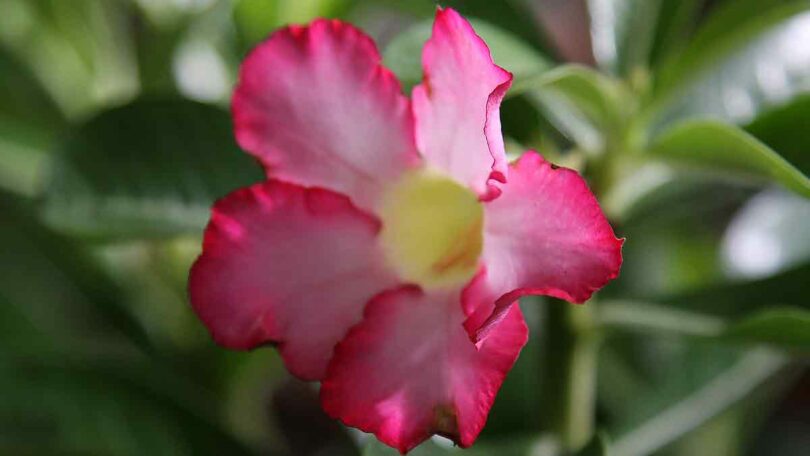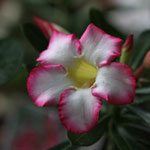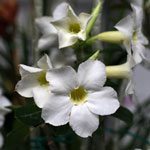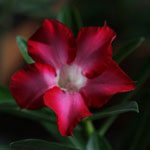
The ‘Desert Rose’
Adenium Obesum is commonly known as ‘The Desert Rose’ and indeed they do grow in dry desert areas. They are native to Eastern Africa and Northern Arabia.
The flowers are attractive and indeed create a rosy picture, the trunks develop a swollen look over time and these easy care plants are also used as Bonsai. And as much as the flowers can be rosy in colour, they are not related to roses at all.
Basic Adenium obesum (Desert Rose) Care
Adeniums require full sun for much of the year for proper care, they can be grown indoors if they receive full light near a window.
Watering
Adeniums are succulent plants from desert areas, they are very good at surviving on little water.
Being a succulent and a wet/dry cycle of watering is required. Water well and then let the soil to dry out between watering again.
One of the most important aspects is match the amount of water they will receive with the growing medium. The more water, the more free draining the growing medium needs to be.
The other aspect of watering is when to water. In active growth Adeniums can take more water, and will put on more growth. During dormancy, they require very little water at all.
When growing in pots try unglazed pots as these plants like to dry out between waterings and terracotta pots are excellent for this.
Overwatering or wet soggy soils will lead to root rot.
Light
Adeniums require good bright light, plenty of sun and warmth. Grow the plant in a position where it receives at least 6 hours of direct sunlight each day. HOWEVER, in very hot dry summers they will perform better under shade cloth.
Indoors, provide bright, indirect light or direct sun but not right next to a window.
Temperature
Adenium obesum prefers warm temperatures and cannot tolerate frost. Keep the plant in temperatures above 50°F (10°C).
Ideally, maintain temperatures between 65-80°F (18-27°C).
Fertilizer
The best way to fertilize Adeniums is with weak applications on a regular basis during the growing season (spring and summer) every 2-4 weeks.
Reduce or stop fertilizing during the dormant season.
Growing Medium
A free draining potting mix is the key to successfully growing Adeniums and preventing problems. Adding vermiculite to a good quality potting mix is a good way to grown them
Pruning
You can easily prune the plant to shape and encourage branching and therefore more flowers. The best time to prune is from late winter to early spring.
Remove dead or yellowing leaves as they appear.
Repotting
Regular repotting is the best way to keep the plants healthy, it will also allow you to create that cuaudex (swollen lower trunk) that is sought after. When you repot, simply pot the plant so it sits a little higher in the pot each time. This is how the great bonsai specimens are created.
Propagation:
Adeniums can be propagated from seeds, cuttings, or grafting.
Wait until planted are established, around 3 years old before taking cuttings.
To propagate from cuttings.
- Take cuttings around 15cm (6 inches) long.
- Allow them to callus over, leave them in a shaded position for 2 – 3 days.
- You can use a powder or liquid hormone rooting powder if you wish.
- Plant them in a normal succulent potting mix in a pot with very good drainage.
- Do not water for 4 – 5 days.
- Keep the plants in a warm position out of direct sun.
- After that keep the soil just moist.
- New growth can take 8 weeks to appear.
- Re pot after 12 months.
Adenium or ‘ Desert Rose’ are available for sale from the following nurseries
370 Bluewater Drive Bluewater Qld 4818
Specialising Adenium, Pachypodium, Euphorbias and other rare exotics. Advanced Adenium "bonsai style" and young plants from imported seeds.
www.nqadenium.com
Succulent nursery for drought hardy plants. Includes: Adenium, Agave, Alluadia, Aloe, Anecampseros, Crassula, Euphorbia, Gasteraloe, Haworthia, Kalanchoe, Ledebouria, Portulacaria, Sedum, Senecio and many others.
CHOICE SUCCULENTS
More Information
Adenium make an interesting bonsai specimen with a fascinating swollen trunk and attractive flowers. A well drained potting mix is essential for adeniums to thrive. Check out other species of adenium such as A. swazicum, A. somalense, A. arabicum, A. crispum and A. multiflorum.
Also known as the ‘Fortune Tree’, in Feng Shui the placement of Adenium obesum on the left side of your front door is said to bring good fortune. And when the ‘Fortune tree’ is flowering this is a particularly lucky period. Although looked at a ‘bonsai’ because of the bulbous base, this is a natural growth habit of Adeniums.
Adenium Varieties
Pictures below show the variety of flower colours available from Adenium Obesum Plants



Adeniums are available in a number of varieties including both single petal and multi petal types. Nurseries have been hybridising Desert Rose plants for a number of years, with great results. Flowers with striped petals and even coloured edge varieties are becoming available.
Grafted varieties are also becoming popular, with the best flowering types being grafted onto rootstocks of other types. Grafted, rather than seed grown not only ensure the flower type and color but also give a more vigorous growth than most seed grown types.
Adenium Obesum is also known as the Desert Rose or ‘Impala Tree’, are available for sale plants from online nurseries.
In Feng Shui Adenenium Obesum is also know as the ‘Fortune Tree’, it is said to bring good fortune if placed to the left of a doorway, they are also used in bonsai.
Other Adenium Species include
A. arabicum, A. boehemianum, A. crispum, A. multiflorum, A. obesum, A. somalense , A. swazicum, A. somalense, A. Thai socotranum and A. socotranum.


